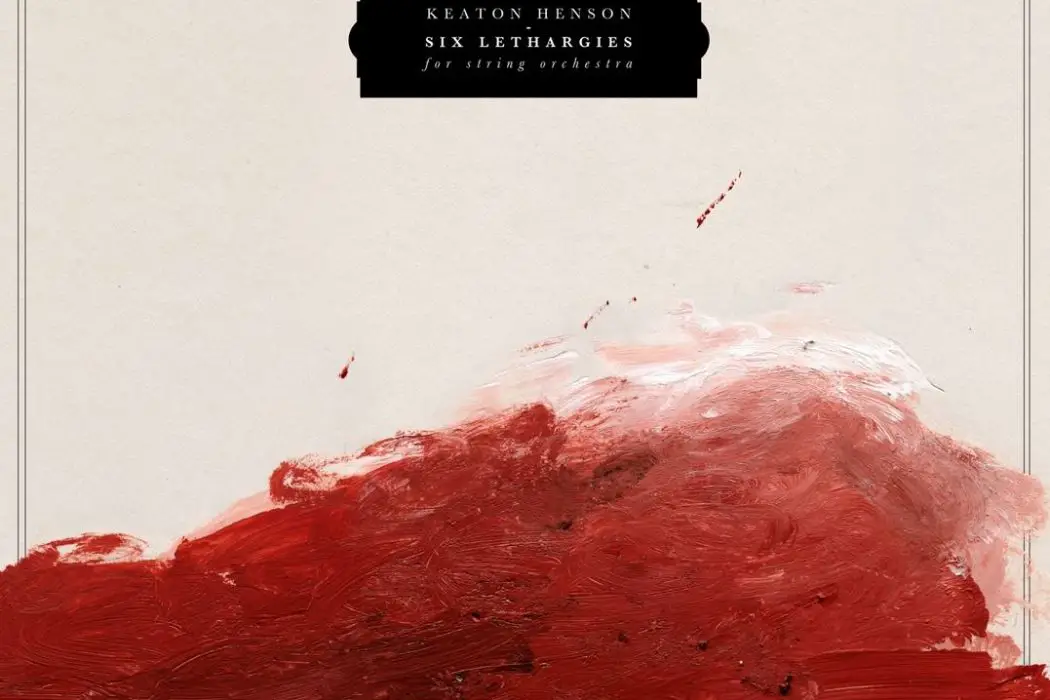Keaton Henson has created a body of music with ‘Six Lethargies’ that enraptures just as much as it haunts, providing a window to the anxiety and depression that festers inside him.
•• •• •• ••
Music, at its core, is a versatile medium. Through melodic shifts and wavering tempos, a new language exists through the notes that conjure up stories in which audiences can become enraptured by. From evocative tales of woe to pastoral odes of brighter days, the emotions that fill the air are palpable and enriching. Because of this, it also acts as the perfect conduit for personal storytelling, allowing artists and musicians alike to dive into their deepest selves and share not through words, but with melodies.

With Keaton Henson, he’s taken this idea to heart. He’s a musician who fears nothing more than performing, and his battles with mental illness often acting as the reason for it. He has struggled with articulating it, but, through music, he has found a voice to share his experiences with depression and anxiety. In July of 2019, Henson conducted a string orchestra to play some of his latest works, all pieces that explore his world and showcase the torture he endures. He called it Six Lethargies.
In October of 2019, Henson released the album, and intensity ran through the heart of all seven pieces, culminating in a listening experience that stirs, haunts, and enchants with one swift movement. On the album, Henson stated, “If I write about how it feels to me, will you feel it, too? If you do, then it proves it is not a mental health issue, it’s a physical health issue. It’s so physical that I can show it to you.”
When performing the pieces in July, some audience members were hooked up to finger sensors their reactions reaction. Based on the data acquired, the lighting systems altered to the feelings of the audience. Though listeners of the album are not hooked up, his sonic explorations elicit the firmest of reactions through the sheer power each piece has. It’s an album nonpareil, one to explore in great depth and lose oneself to with an unshakeable fervor.
‘Six Lethargies’ – Keaton Henson
Initium
A simple “Initium,” or, when translated from Latin, beginning that swells into a momentous end which acts as the calm before the storm. A somber buildup of chord progressions that gains its strength through the incrementally rising volume of its pitch, allowing it to increase in tension and strife, elements that become staples on the album as a whole.
Melodic viola and violin coalesce into soundwaves of beauty and of apprehension. In the foreground, single, long-held notes aid in building the piece, providing an extra layer that serves to only heighten the experience and give Henson the tools to paint the feelings festering inside him with auditory excellence.
The climax of the piece at the end is an onrush of immense bravado that will overwhelm and stun, but listeners will invite it in nonetheless. It’s an enthralling experience that provides a gorgeous introduction into Henson’s mind and the struggles he endures. The strings quiet and the playing slows, ending the piece with a silent exclamation.
Listen: “Initium” – Keaton Henson
The Falling
The beginning of the piece sees the strings perform a set of rises and descends, creating brief moments of reprieve that titillate and leave listeners aching for the next set of chords to be played. It’s soft in its presentation, casually growing in sound and volume. That pace is suddenly disrupted by a sudden jolt of sonority—a powerful stamp on the piece that distinguishes the many sub-movements that live within this central piece.
Repetition from the viola section becomes apparent as a heavier presence begins to grow. Sparse violin wafts around the melody from the viola, and when joined by the booming tones of the cello and bass, act as a setup for something grand. It’s brisk and unassuming, and as the notes keeping being played, the listeners’ ears become more attuned to the happenings of the piece, waiting for the next step. And then panic ensues.
Frantic violin interrupts the otherwise placid piece and morphs it into a sharp descent into madness, a falling into the anxiety that embraces Henson. Hairs will rise and hearts will hasten in beat—it’s a moment of dread that shake listeners and provides a vivid image of the turmoil existing in the artist. The piece ends with rapid playing that builds and builds to only suddenly stop, leaving listeners with the need to catch their breaths.
Trauma / In Chao
The piece as a whole is a hallucinatory buildup of tension. A deafening silence is introduced at the piece’s start that bewilders but excites. The device employed throughout is the Shepard tone, an auditory trick that subverts the senses and gives off the impression of increasing note pitches, all while actually doing nothing of the sort. One expects a finale, a final stamp that ends the madness and will calm the nerves, but listeners are left wanting. It’s chaos, and it’s absolutely exhilarating.
Atonality surrounds the piece as well, assisting in the mirage that is taking place with the Shepard tone. The structure of the piece is loose, making way for a harmony that, at times, seems unapparent but is nonetheless still there, residing in what seems like secrecy. It’s a practice uncommon for most modern-day Western music, but its employment here by Henson is world-class.
Unease Concerto – Cadenza & Unease Concerto
The two pieces fit together in a harmonious fashion, making a seamless jump from one melody to the next. The first movement, “Cadenza,” does its title justice by growing a sense of unease. It never becomes overbearing, however. Its presence gives a small window into Henson’s world, a sample of what’s to come. The peering does not last too long, the movement ending softly as it readies for the main show.
High notes laden with unrest begin the next piece but are soon stopped. Angelic, wistful playing takes the spotlight and, for a moment, a rush of inner pieces is born. The peace was ephemeral, soon being wrapped in a ball of panic as the strings clash and build. It’s a sudden transition, but one that provides greater insight into how Henson lives, what he must undergo in his daily life. The sudden ups and downs are reflective of his own mind, and it’s one of torment.
As the piece continues, a weight becomes added with the new frenzied playing. As done previously, it’s short-lived, but their reoccurring presence continuously gains momentum, each new moment of anxiety getting louder and more tumultuous. The distressed intervals soon morph into something sinister, though. A haunting glimpse into Henson’s life.
At the piece’s end, violin is played sul ponticello, meaning the bow is near the bridge which allows for nasally, eerie tones to be created. The higher harmonics utilized borderline terrifying, but one would be hard-pressed not to be intoxicated by the experience of it all. The agitation and worry subside, and the piece ends with a calming presence that listeners will most definitely need.

Lament
“Lament” offers a somewhat sinuous ride as the main melody throughout the piece undulates with a wistful refinement. When compared to the other pieces, it’s a much simpler item to grasp. There is a growth of around 10 chords being played, gradually increasing in scope that expands and then subsides. Each new dissonance has a resolution, earnestly beginning and ending as if each tone interval is a new thought Henson is sharing and feeling.
The piece flows in a melodious fashion, bolstering its resolve as it nears the finale. The strings swell and impassioned playing permeates throughout. The smooth chord progressions are this piece’s weapon, and it brandishes it well. The melody only becomes richer and fuller in sound, creating one of the more evocative pieces on the album as a whole.
Breathing Out
All of the tension, the turmoil, and the heartache has led to this point, and it’s an ending that serves the album well with immense sincerity and grace. Any horrors that laid before have been put to rest, “Breathing Out” working with tones and melodies of a celestial quality that bring about a beautiful sadness with each note struck. It grips tightly but still eases listeners, lowering the heart rate and creating a canvas of imagery that is of Henson’s creation.
The ups and downs of his life are on full display as the strings reach a crescendo and become a boisterous display of raw emotion and powerful control. As the piece moves onward, the cello section gains a bit of spotlight as they hold together a rhythm that accentuates the highs of the violin to make a stirring movement that will undoubtedly have tears be shed.
It’s the culmination of all the good and bad, a piece that finishes the dialogue and provides one final image of the emotions that live inside Henson. His goal of expressing his sorrows and his troubles has been achieved in a poignant and touching manner, and with a job well done, the last few notes are ones of tenderness, closing out his story with a meaningful period.
Listen: “Breathing Out” – Keaton Henson
Six Lethargies
Though not in a live ensemble as the original production, Six Lethargies still proves to be one of the most moving pieces of music of the last decade. Keaton Henson has shown to be an exceptional musician, artist, poet, and, now, composer. He has struggled with depression and anxiety for years and finding ways to relay his inner strife, and Six Lethargies might just be his best step in that direction, offering a visceral listening experience that conjures an image of the turbulence he braves through lilting melodies and impassioned melodies. There is quite no other album like it, and one would only be doing themselves a disservice by not experiencing it.
— —
:: purchase Six Lethargies here ::
— — — —

Connect to Keaton Henson on
Facebook, Instagram
Discover new music on Atwood Magazine
? © 2019
Six Lethargies
an album by Keaton Henson









